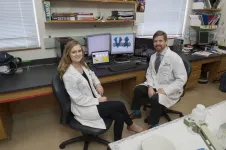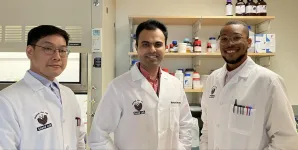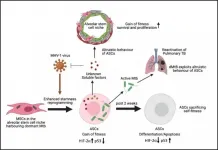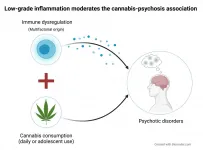(Press-News.org) DALLAS (SMU) -- A team of SMU biological scientists has confirmed that P-glycoprotein (P-gp) has the ability to remove a toxin from the brain that is associated with Alzheimer's disease.
The finding could lead to new treatments for the disease that affects nearly 6 million Americans. It was that hope that motivated lead researchers James W. McCormick and Lauren Ammerman to pursue the research as SMU graduate students after they both lost a grandmother to the disease while at SMU.
In the Alzheimer's brain, abnormal levels of amyloid-β proteins clump together to form plaques that collect between neurons and can disrupt cell function. This is believed to be one of the key factors that triggers memory loss, confusion and other common symptoms from Alzheimer's disease.
"We were able to demonstrate both computationally and experimentally that P-gp, a critical toxin pump in the body, is able to transport this amyloid-β protein," said John Wise, associate professor in the SMU Department of Biological Sciences and co-author of the study published in PLOS ONE.
"If you could find a way to induce more P-glycoprotein in the protective blood-brain barrier for people who are susceptible to Alzheimer's disease, perhaps they could take such a treatment and it would help postpone or prevent the onset of the disease," he said. Wise stressed that the theory needs more research.
The SMU (Southern Methodist University) study also provides strong evidence for the first time that P-gp may be able to pump out much larger toxins than previously believed.
P-gp is nature's way of removing toxins from cells. Similar to how a sump pump in your house removes water from the basement, P-gp swallows harmful drugs or toxins within the cell and then spits them back outside the cell.
"You find P-gp wherever the body is looking to protect an organ from toxins, and the brain is no exception," explained co-author Pia Vogel, SMU professor and director of SMU's Center for Drug Discovery, Design and Delivery.
Amyloid-β's large size created questions about whether P-glycoprotein could actually inhale it and pump it back out.
"Amyloid-β is maybe five times bigger than the small, drug-like molecules that P-glycoproteins are well-known to move. It would be like taking New York pizza and trying to stuff that whole slice in your mouth and swallow it," Wise said.
The fact that P-gp appears to be able to do just that "greatly expands the possible range of things that P-gp can transport, which opens the possibility that it may interact with other factors that were previously thought impossible," said McCormick, a former SMU graduate student in biological sciences.
The research was personal
SMU researchers might never have investigated the link between P-gp and amyloid-β proteins if not for McCormick's dogged pursuit of the connection. The Ph.D. student, who graduated in 2017, had seen preliminary work suggesting that P-gp might play a role in pulling amyloid protein out of the brain and asked his faculty advisors, Vogel and Wise, if he could take some time to check it out.
The professors concede they first tried to discourage him because they were more focused on P-gp's role in creating resistance to chemotherapy in cancer patients. However, McCormick was "passionate," about figuring out if P-gp might be able to shield someone from getting Alzheimer's, Vogel said.
He devoted hours of his own time to use a computer-generated model of P-glycoprotein that he and Wise created. The model allows researchers to dock nearly any drug to the P-gp protein and observe how it would behave in P-gp's "pump." Vogel, Wise and other SMU scientists have been studying the protein for years to identify compounds that might reverse chemotherapy failure in aggressive cancers.
McCormick completed the computational work with the help of his fiancé, Ammerman, who got her Ph.D in biology from SMU in May.
Together, they ran multiple simulations of the P-gp protein using SMU's high performance computer, ManeFrame II, and found that each time, P-gp was able to "swallow" amyloid-β proteins and push them out of cells.
"For the scientist in me, it was just absolutely amazing that this pump could consume something that big," Vogel said. "John [Wise] and I did not predict that would be possible."
Two in vitro experiments confirmed the computational work
The researchers conducted two experiments in the lab to confirm the computational results.
In one experiment, Ammerman used lab-purchased amyloid-β proteins that had been dyed fluorescent green, allowing them to be easily spotted easily in a microscope. In multiple trials, Ammerman exposed human cells to these amyloid-β proteins. She used two types of human cells -- one where P-gp was strongly expressed and one where P-gp was not. This allowed Ammerman to test the difference between the two and see if P-gp was pumping amyloid-β out.
The amyloid proteins were clearly shown to be pushed out of the human cells that had overexpressed P-gp in them, supporting the theory that P-gp removes amyloid proteins on contact.
Another in vitro experiment reached the same conclusion from a different direction. Former graduate student Gang (Mike) Chen worked in SMU's Center for Drug Discovery, Design and Delivery to show that an Alzheimer's-linked amyloid-β caused changes in the P-gp's usage of adenosine triphosphate (ATP), indicating that there was a physical interaction between the two.
ATP hydrolysis produces the energy that P-gp uses to transport toxins or drugs out of the cell. When no toxins are present, P-gp's rate of ATP stays pretty low. When challenged with transporting cargo, P-gp's ATP hydrolysis activity usually increases quite dramatically.
"Even though our work can't help our grandparents, I hope that it might help others in the future," Ammerman said. "The more we know, the more power we have - and researchers after us - to address and target these devastating diseases."
INFORMATION:
About SMU
SMU is the nationally ranked global research university in the dynamic city of Dallas. SMU's alumni, faculty and nearly 12,000 students in eight degree-granting schools demonstrate an entrepreneurial spirit as they lead change in their professions, communities and the world.
Why can some people weather the stress of social isolation better than others, and what implications does this have for their health? New research from the Communication Neuroscience Lab at the Annenberg School for Communication at the University of Pennsylvania found that people who felt a strong sense of purpose in life were less lonely during the COVID-19 pandemic. Did they achieve less loneliness by flouting public health guidance? No. Although lonelier people were less likely to want to follow public health guidance, people with a stronger sense of purpose also expressed more willingness to engage in social distancing, hand washing, and other ...
A new study looking at the way human cells activate the immune system in response to SARS-CoV-2 infection could open the door to even more effective and powerful vaccines against the coronavirus and its rapidly emerging variants keeping the global pandemic smoldering.
Researchers from Boston University's National Emerging Infectious Diseases Laboratories (NEIDL) and the Broad Institute of MIT and Harvard say it's the first real look at exactly what types of "red flags" the human body uses to enlist the help of T cells--killers sent out by the immune system to destroy infected cells. Until now, COVID vaccines have been focused on activating a different type of immune cell, B cells, which are responsible for creating antibodies. Developing vaccines to activate ...
Steroid (sex) hormones play a central role in sexual development: They help determine how boys become boys and girls become girls. If these hormones are disrupted during fetal life, it can lead to a string of reproductive disorders at birth and later in life, including malformed genitals and decreased fertility.
Many environmental chemicals are known to disrupt the hormone system and are often referred to as endocrine disrupting chemicals. Azole fungicides constitute one group that can act as endocrine disruptors. Azoles are used to combat yeast infestations in seed and food crops, but are also used in medications for humans.
Most azoles used in medicines are tightly regulated and their use is well controlled. However, some are sold over-the-counter, for ...
Philadelphia, June 16, 2021 - The SARS-CoV-2 virus that causes COVID-19 may have the ability to reactivate dormant tuberculosis (TB). In a novel study scientists END ...
In a new publication from Cardiovascular Innovations and Applications; DOI https://doi.org/10.15212/CVIA.2021.0011, Xiao-lei Yin, Dong-xue Liang, Lu Wang, Jing Qiu, Zhi-yun Yang, Jian-zeng Dong and Zhao-yuan Ma from Tsinghua University, Beijing, China; Capital Medical University, Beijing, China and The First Affiliated Hospital of Zhengzhou University, Zhengzhou, China analyse coronary angiography video interpolation methods to reduce x-ray exposure frequency based on deep learning.
Cardiac coronary angiography is a major technique that assists physicians during interventional heart surgery. Under X-ray irradiation, the physician ...
In a new publication from Cardiovascular Innovations and Applications; DOI https://doi.org/10.15212/CVIA.2021.0013, Sharen Lee, Gary Tse, Xin Wang, Adrian Baranchuk and Tong Liu from Laboratory of Cardiovascular Physiology, Hong Kong, China, Second Hospital of Tianjin Medical University, Tianjin, China and Queen's University, Kingston, Ontario, Canada consider ST-segment depression in leads I and aVL.
The 12-lead electrocardiogram (ECG) is a routinely performed test but is susceptible to misinterpretation even by experienced physicians. The authors report a case of a 72-year-old lady with no prior cardiac history presenting with atypical chest pain. Her initial electrocardiogram shows an initial ST depression followed by positive deflections leads I and aVL. ...
Commonplace pharmaceuticals, such as ibuprofen, can carry with them an inherent flaw in their atomic structure, which pairs the active, beneficial ingredient with a potentially ineffective -- or even toxic -- counterpart. New research could hold the key to more easily isolating the good while removing the unwanted.
Dr. Shoufeng Lan, assistant professor in the J. Mike Walker '66 Department of Mechanical Engineering at Texas A&M University, is leading a team investigating the use of electromagnetic control over the synthesis of chiral compounds at an atomic level -- a process that could lead to a plethora of practical ...
How do top athletes talk about doping when they themselves are using performance-enhancing drugs? Or do they just avoid the issue? A new study by the University of Göttingen reveals that any decision to use drugs almost inevitably means the decision to engage in deceptive communication such as lying or omitting information. Those using drugs, for example, regularly describe anti-doping policies as being more intense than ever or overly restrictive, play down the extent of the doping problem, or portray themselves as victims. The results were published in the European Journal for Sport and Society.
Dr Marcel Reinold, Head of Sport and Health Sociology at the Institute of Sport and Exercise Sciences at Göttingen University, analysed autobiographies of professional ...
A new paper in the journal Cognition examines the visual complexity of written language and how that complexity has evolved.
Using computational techniques to analyze more than 47,000 different characters from 133 living and extinct scripts, co-authors Helena Miton of the Santa Fe Institute and Oliver Morin of the Max Planck Institute for the Science of Human History, addressed several questions around why and how the characters of different writing systems vary in how complex they appear.
"When we started this project, we wanted to test whether you find a general simplification of characters over time," Miton says. "Do scripts simplify their ...
The presence of pro-inflammatory cytokines in the blood can boost the effects of daily cannabis use and heighten the risk of developing psychosis in adulthood. Similar results have been observed, also in the presence of cytokines, when cannabis is used during adolescence. Psychotic disorders have symptoms such as delirium, loss of a sense of reality, hallucinations, hearing voices, and cognitive and social impairments.
A study by researchers at the University of São Paulo's Ribeirão Preto Medical School (FMRP-USP) in Brazil, reported in an article in ...




